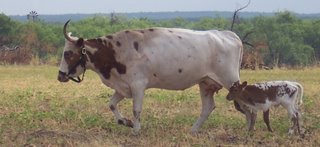
Our next venture into animal husbandry was cattle. We initially wanted them as another source of food, specifically for myself steaks and burgers! 🙂
I cannot recall exactly how it all unfolded, but I believe Michael had considered Texas longhorns as a possibility, perhaps because they are Texas cattle; there may have been other reasons. And then God’s providence would have it that the naturopathic doctor Sue and I were seeing knew one of the foremost Longhorn cattlemen around, Frank Sharp, and he lived in the major town near us. So we called him and started discussing Longhorns. Come to find out he not only knew about Longhorn cattle, but had done his doctoral dissertation on them. And so, the Lord was gracious in leading us to him, and then the registry group of which he is a part, the Cattlemen’s Texas Longhorn Registry: the CTLR.
Rather than myself explain why we went the Longhorn route, Michael did in a blog on it:
True and pure Texas Longhorns are profoundly different from the commercial cows (actually European breeds) that are available today. So it is not just a few minor trait differences we are looking at, but actually the Longhorn is “a whole different animal”.
The pure Longhorn is a smallish example of cattle. The female rarely tops 800 lbs. The Steer or Bull may get upwards of 1800 lbs. but it will take him 5-6 years to get that big.
The Longhorn thrives on stuff other cows will not even eat. They will eat weeds, thistles, scrub brush, etc. as well as grass when it is available. The result of these first two traits is that you can keep 3 Longhorns in the same area where you could only keep one commercial cow. The commercial cow is designed (by humans) to live a fairly short life. Finding a 10 year old commercial European breed cow is very, very rare. The commercial cow will likely only produce up to 5 or 6 offspring in their short lives. The Longhorn, however, can live very long lives, and it is not unheard of to have a cow still producing a calf (every 10-11 months) well into their 20’s and 30’s. The Longhorn breeds back faster than any other cow. The old saying by ranchers is that the Longhorn will calf every 9 months and 15 minutes.
The Longhorn survived and thrived in the deserts of Texas and Mexico without any aid from or crossbreeding by man. The commercial breeds are concoctions of man… the true Longhorn is a product of God. After hundreds of years living wild in Texas and Mexico, there were literally millions of pure Longhorn cattle free for the taking. This is what started the “cattle drives” of western fame. The Longhorn saved Texas after the disastrous war of northern/industrial aggression.
So how is the meat?
Longhorn meat is higher in “good” fats, lower in “bad” fat, and higher in protein than any other beef. It is naturally one of the most tender examples of beef, even though it is the lowest in saturated fats. I was given a couple of pounds of Longhorn hamburger and it was some of the best hamburger meat I have ever eaten.
Longhorn steers can be made into oxen (and have for centuries). Longhorns can be ridden and milked.
Longhorns are the only breed where almost 100% of the cow is usable and profitable. Not only is their meat great, but the horns regularly sell for between $400-$1500 dollars. The hides sell for between $400-$700. Online you can buy Longhorn pillows, couches and blankets (try to buy an Angus blanket!). The tails are often made into lamps and even putters! An industrious Longhorn owner can sell the hides and horns for more than a whole commercial breed cow will sell for at market. This doesn’t count the meat at all!
The main points for the homesteader:
1. 3/1 ratio of Longhorns to a commercial cow in the amount of cows per acre.
2. There is no known case (of which I have either read or heard) of a Longhorn cow having to have a calf “pulled”. Ease of calving is a famous trait of Longhorns, and it is why many, many commercial breeders now have their cows bred to a Longhorn bull for their first calf.
3. Low feed costs and the ability to keep a cow on land that might not be good enough for a commercial cow.
4. Multiple uses of the Longhorn. Milking, riding, pulling, work, etc.
5. Easy sale of all the “parts”.
6. Quality of the meat.
Well, this seemed like a no-brainer to us; and with the CTLR folks’ help, we were able to begin our herd.
In having animals on the farm, we have learned that is seems each type of animal has its own naming conventions for adults, its offspring, etc. I would like to quickly go over a few definitions of words that regard cattle that might be used in this post. I never knew these before owning any, and even at the beginning when people would use the words, I would sort of just nod my head and smile. 🙂 And so:
– A “calf” is a young cattle offspring
– A “bull” is an un-castrated male
– A “steer” is a castrated male
– A “heifer” is a female that has never given birth
– A “cow” is a female that has
And so, a newly born male would be referred to as a “bull calf”, and likewise a newly born female a “heifer calf.”
Our Herd
In naming our cattle, we wanted to have a Spanish theme for ours, given the heritage of Longhorns. The picture at the top of this post Amistosa (“friendly”) and her calf Tiara (because she has a crown of white on her head).
Here are some other pictures of the cows and heifers we own. This is Rosa (“rose”) and her calf Rosalinda (“pretty rose”, and that she came from Rosa):
This is Ami and her latest calf Casi Blanca (“almost white”):
This is Catalina (“pure”), which we bought from Frank:
And here is Rosa’s latest calf Rociada (“sprinkled”, because of the coloring on her face and the “ros” sound, like in her mother’s name):
Although the horns of the Longhorn can be intimidating, and one must be careful around them (especially not to startle them and to pay attention to the possibility of accidental horning), the Longhorns are very gentle generally. Tiara’s like a puppy dog now in how she behaves, and here’s a picture of me training Tiara:
It’s interesting to note that while it might be thought that Longhorns’ horns are their main weapons against predators, apparently their preferred method of protection is stomping an attacker to death. The newborns also learn to get around quickly so as to be less vulnerable to predation.
Recently we had to move the herd from one field to another about 2/5 of a mile down the county road. Needless to say I had stopped a couple of times during the jaunt. Just a couple of notations: The first heifer to come across the line was said to be Maria, but actually it was her calf Pita (both owned by Michael). Also, the bull mentioned, Quitachon, was not actually our bull but was borrowed from Sonny Detmer of the CTLR:
One thing we’ve learned about cattle is that they get into everything. You have to fence them out of areas in which you don’t want them. But when they get in, they step on things and break them, they’ll get into your chicken tractor and eat the chicken feed, and a 4 foot fence around an orchard tree will not keep them from eating the tree down. Plus, some of the cows are quite dexterous and will jump your fence to get to greener pastures, which means chasing them or luring them back to the field in which you want them with “range cubes”. Range cubes are feed pellets that are anywhere from an inch to 3 inches long and about 1/2 to 3/4 of an inch in diameter, and the cattle love them! Further, if a gate is left open and they all get out, it ends up being an all out round up trying to get them back to their proper place. However, if you can get one or a few of them going, the rest typically follow, sticking with the herd (just like in the above cattle drive).
It has been a blessing to be able to have the cattle that God has granted us. In the long run, for us to keep animals, they need to perpetuate. The Lord has been gracious in allowing our cows to reproduce; and this year, Lord willing, our first heifers born on the land will be producing their own offspring. We are thankful again for God’s provisions.
— David
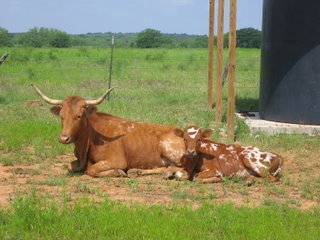
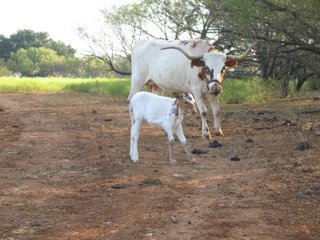
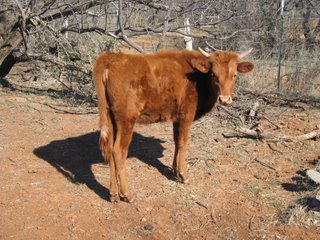
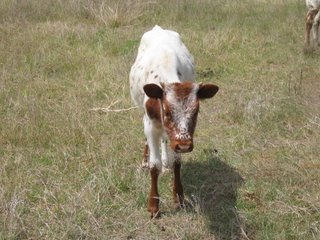
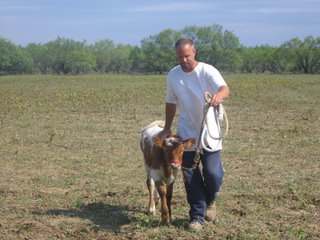
Loved the cattle drive…. Thanks for the video. 🙂 On my drive home each evening I drive past a herd of Longhorns. I must say that they are magnificent animals, especially the bull, but the horns do scare me. I don’t think I would be brave enough to own them. I’m more of a goat person. LOL
Best to you. Manette
Hi Manette,
Although the horns can be intimidating, if care is taken around them (esp. not to startle them and to pay attention to accidental horning), they really are pretty gentle. But like I said, you still do have to watch out.
Thanks for the comment.
— David